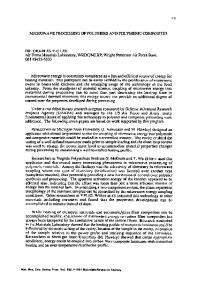Advanced Processing of Composites
- PDF / 1,554,887 Bytes
- 7 Pages / 604.8 x 806.4 pts Page_size
- 62 Downloads / 554 Views
advanced materials in highly loaded structures, in long-term operation, and in a commercial air transport environment. The technical trade-offs are straightforward; defining the proper balance of properties, however, will demand the very best from the research and engineering community. For example, we know that advanced composites and laminar flow concepts have led and will continue to lead to significant weight reduction and aerodynamic efficiency improvements, but more are needed. The a d v a n c e d m a t e r i a l s for the Aerospace Plane must be both exceedingly heat resistant and exceedingly strong. They must be able to withstand operating temperatures of 1200 to 1800°F, and they must have specific strength factors of 600,000 to 1.4 million inches measured in terms of pressure per unit density. Conventional metals, alloys, ceramics, and polymeric composites are approaching a developmental limit in terms of material p r o p e r t i e s for aerospace applications. This limit is based on fatigue as well as thermal strength criteria. Several materials including Rene 41, which has the necessary temperature-resistant characteristics for the Aerospace Plane, lack the required strength factor. The need for cost-effective, high quality processing technology is an essential component of materials R&D. Realtime, on-line process control systems, computer modeling using both expert and advanced artificial intelligence systems, and advanced sensor development must complement the fundamental material sciences.2 Background Polymer-based composite materials used in commercial and aerospace
applications are often based on a matrix of thermocuring polymers usually cured in an autoclave. Under the effects of temperature, the polymer molecules grow into longer chains and crosslinks. The rate of the reaction is a complex function of the temperature and pressure, which depends on the thickness and geometry of the part being made, on the thermal equilibrium between the part and the mold, on the temperature of the atmosphere around the part, and/ or on the thermal mass of the autoclave. Monitoring the viscoelastic properties of the resin provides important information on the state of the cure. This article presents results for a hightemperature ultrasonic viscosity sensor. The resin's complex shear modulus at 1 MHz is derived from the measured reflection coefficient of shear wave pulses at the tool-resin interface. A special transducer-buffer assembly that operates at high temperature and provides a reference calibration signal has been developed. With this assembly, absolute determinations are made throughout the cure cycle of the storage (real) and loss (imaginary) components of the shear modulus from the latter of which the high-frequency dynamic viscosity is calculated. Information from the advanced sensors forms an important input into our computerized modeling and simulation program to determine the state of the cure and to simulate the remainder of the cure cycle. This program is an extension of the modeling programs develo
Data Loading...











